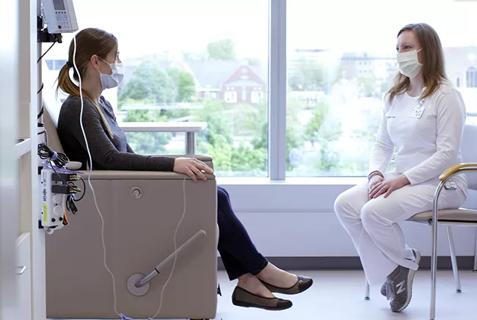Cleveland Clinic Cancer Advances · Nomograms
Advertisement
Cleveland Clinic is a non-profit academic medical center. Advertising on our site helps support our mission. We do not endorse non-Cleveland Clinic products or services. Policy
Oncologists traditionally rely on clinical stages, pathologic stages and risk groups for predictions. But nomograms enable clinicians to place everything they know about a patient into one model that is optimized for prediction.
“In oncology, we’re so used to lumping [patients] into buckets based on stage, but we really lose out on the personalization aspect,” says Rahul Tendelkar, MD, a radiation oncologist at Cleveland Clinic Cancer Center. “Patients come in with a new diagnosis and they want to know what are my chances – not what is the larger group’s [chances]. And so these nonograms we use on a regular basis in our clinics try to help patients.”
In a recent episode of Cleveland Clinic’s Cancer Advances podcast, Dr. Tendelkar and Michael Kattan, PhD, chair of the Department of Quantitative Health Sciences at Cleveland Clinic, talk about nomograms for prostate and breast cancer, including:
Click the podcast player above to listen to the episode now, or read on for a short edited excerpt. Check out more Cancer Advances episodes at clevelandclinic.org/podcasts/cancer-advances or wherever you get your podcasts.
Dr. Kattan: The nomogram term, strictly speaking, applies to the visual on the piece of paper. But it gets morphed into basically a kind of a comprehensive prediction model and equation, which is underneath the hood of the thing. So, you could take the equation and show it on a sheet of paper. You could also make a smartphone app. You could put it directly into your electronic health record system. And so, it just automatically runs.
Advertisement
We’re always looking for ways to make you [clinicians] more efficient. I’m trying to dive into areas where you folks struggle with decisions. Those are the fun ones for me. If you’re in a no brainer situation where you’re going to treat this patient, like so and so, and you don’t really need a prediction to guide you on that, you probably don’t need a nomogram very much for that. But ones where it’s controversial, and you don’t know whether to do A or B and there’s counterarguments and all this stuff – that’s where I like to give you tools to take the prediction part out of it. So that you’re not basically fighting about predictions. You’re more fighting about the outcomes that are at stake and how important they are, and how much the patient cares about them and involving the patient and that, and just get the math off of your plate.
Advertisement
Advertisement

Use of GLP-1s and improving cardiovascular health lowers risk of hematologic malignancies

Slower drug elimination from the body among females may impact safety and efficacy

Integrated program addresses growing need for comprehensive cancer care among adolescents, young adults and adults under 50 with early onset cancers

Study demonstrates potential for improving access

Approach could help clinicians identify patients at an increased risk of progression who could benefit from more aggressive treatment

Gene editing technology offers promise for treating multiple myeloma and other hematologic malignancies, as well as solid tumors

Majority of 1,000 patients seen in 2022 discharged home